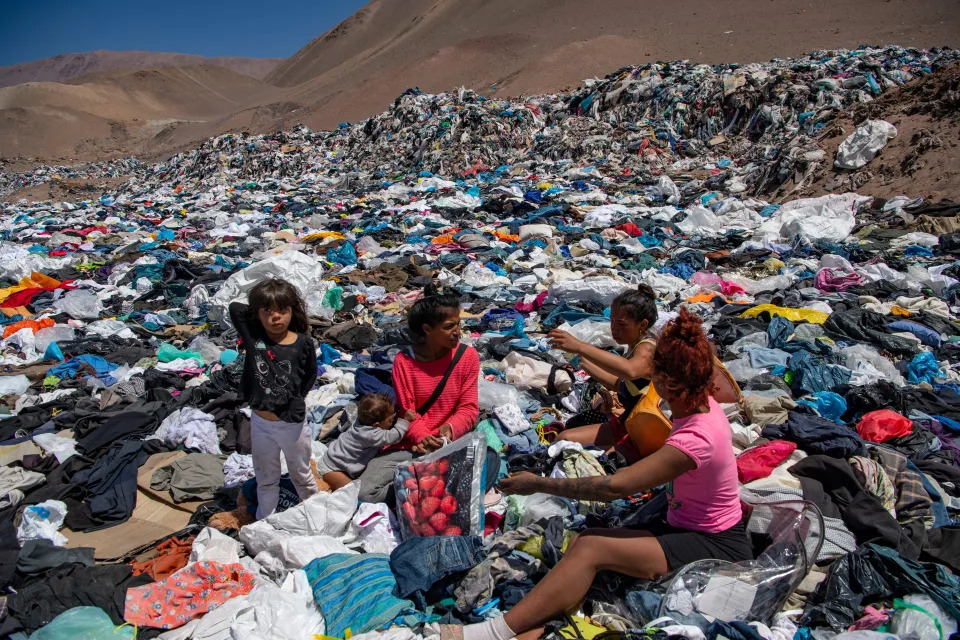Matthew Loh
Mon, May 22, 2023

A woman searches for clothes in the Chilean Desert.
Martin Bernetti/AFP via Getty Images
A gigantic heap of unused clothes in Chile is so big that a satellite can easily spot it.
High resolution images of the clothing dump was posted on May 10 by satellite photo app SkyFi.
Much of the landfill contains clothes that couldn't sell in stores in the US, Europe, and Asia.
A giant dump of unused fast fashion clothing in Chile's Atacama Desert is now clearly visible to satellites.
The still-growing mountain of discarded or unworn clothes — manufactured in Bangladesh or China and sent to retail stores in the US, Europe, and Asia — are brought to Chile when they aren't sold, according to Agence France-Presse.
At least 39,000 tons of those clothes accumulate in landfills in the Atacama Desert, the outlet found in 2021.
On May 10, a high-resolution satellite photo of the discarded clothes was posted in a blog by SkyFi, the developers of a satellite photo and video app.
The clothes can't be sent to municipal landfills because they aren't biodegradable and often contain chemical products, Franklin Zepeda, the founder of EcoFibra, a company that tries to reuse the textiles by making insulation panels, told the AFP.
So the unused garments sit next to Chile's Iquique port, about a mile from some of the city's poorer neighborhoods.
The landfill sometimes attracts migrants and local women, who search the dump for items they can wear or sell, per AFP.

Women search for clothing items in the Atacama Desert
A gigantic heap of unused clothes in Chile is so big that a satellite can easily spot it.
High resolution images of the clothing dump was posted on May 10 by satellite photo app SkyFi.
Much of the landfill contains clothes that couldn't sell in stores in the US, Europe, and Asia.
A giant dump of unused fast fashion clothing in Chile's Atacama Desert is now clearly visible to satellites.
The still-growing mountain of discarded or unworn clothes — manufactured in Bangladesh or China and sent to retail stores in the US, Europe, and Asia — are brought to Chile when they aren't sold, according to Agence France-Presse.
At least 39,000 tons of those clothes accumulate in landfills in the Atacama Desert, the outlet found in 2021.
On May 10, a high-resolution satellite photo of the discarded clothes was posted in a blog by SkyFi, the developers of a satellite photo and video app.
"The 50 cm resolution image, which is classified as Very High Resolution, was taken using satellite imagery, and it shows how big the pile is compared to the city in the bottom of the picture," the developers wrote.
The clothes can't be sent to municipal landfills because they aren't biodegradable and often contain chemical products, Franklin Zepeda, the founder of EcoFibra, a company that tries to reuse the textiles by making insulation panels, told the AFP.
So the unused garments sit next to Chile's Iquique port, about a mile from some of the city's poorer neighborhoods.
The landfill sometimes attracts migrants and local women, who search the dump for items they can wear or sell, per AFP.

Women search for clothing items in the Atacama Desert
.MARTIN BERNETTI/AFP via Getty Image
The fast fashion industry aims to give consumers affordable access to fashion trends but contributes between 2 to 8% of the world's carbon emissions, the United Nations found in 2018.
Nearly 85% of all textiles go to dumps every year, and fashion production consumes vast amounts of water and pollutes rivers and streams, Insider's Morgan McFall-Johnsen previously reported.
The Ellen McArthur Foundation, a UK think-tank, estimated that enough clothes to fill a garbage truck are burned and sent to a landfill every second.
Fast fashion's market size is expected to grow to $122.9 billion in 2023, up from $106.4 billion in 2022, according to market research firm The Business Research Company.
The fast fashion industry aims to give consumers affordable access to fashion trends but contributes between 2 to 8% of the world's carbon emissions, the United Nations found in 2018.
Nearly 85% of all textiles go to dumps every year, and fashion production consumes vast amounts of water and pollutes rivers and streams, Insider's Morgan McFall-Johnsen previously reported.
The Ellen McArthur Foundation, a UK think-tank, estimated that enough clothes to fill a garbage truck are burned and sent to a landfill every second.
Fast fashion's market size is expected to grow to $122.9 billion in 2023, up from $106.4 billion in 2022, according to market research firm The Business Research Company.
No comments:
Post a Comment